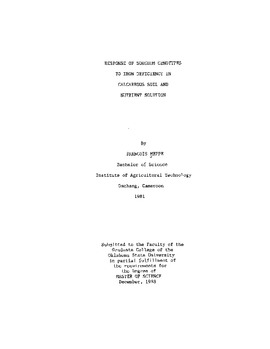| dc.description.abstract | Sorghum (Sorghum bicolor (L.) Moench) grown on calcareous soils is subject to a number of limiting factors, one of which is iron (Fe) deficiency. The American Great Plains, including Western Oklahoma, contain many calcareous soils where moderate to severe Fe-deficiency problems exist. Substantial sorghum yield losses in both grain weight and dry matter from Fe deficiency have been observed, but are not well documented and may occur even when symptoms are moderate. Nutrient solutions and calcareous soils have been used to screen sorghum cultivars for Fe efficiency however, across sorghum genotypes there have been varying degrees of response to these growth media. Research correlating leaf chlorophyll content with visual scores has established the usefulness of visual evaluation of Fa-deficiency chlorosis. The objectives of this research were (1) to screen ten sorghum genotypes for iron (Fe) efficiency in the growth chamber using an Fadeficient solution and in the greenhouse and field using a calcareous, Fa-deficient soil from Northwestern Oklahoma; and (2) to evaluate the effect of Fe deficiency on leaf chlorophyll content, plant dry matter, and grain weight of the ten genotypes grown under growth chamber, greenhouse, and field conditions, respectively. Ten sorghum cultivars were grown in 1987 at the Southern Great Plains Research Station, Woodward, Oklahoma, on two soils (a Woodward loam-Typic Ustochrepts, calcareous, and a Carey loam-Typic Argiustolls, non-calcareous) to determine their tolerance to irondeficiency field by a visual evaluation method and the effect of Fe � deficiency on grain weight. The same ten genotypes were grown simultaneously in a growth chamber, the same year, in two nutrient (+Fe and -Fe) solutions. In 1988, they were grown in a greenhouse in two soils one of which was collected from the Woodward trial site (Woodward loam) and the other from Perkins (a Teller loam-Udic Argiusto1ls). These growth media were used to evaluate the Fedeficiency tolerance of those cultivars and the effect of Fe shortage on their plant biomass and leaf chlorophyll content. In 1988 the field experiment was repeated on Woodward loam only for the same objectives previously described except visual symptoms and leaf chlorophyll content were evaluated. Narrow ranges of Fe-deficiency responses were obtained among genotypes grown in the three environments. However, some cultivars exhibited distinct chlorosis symptoms in the growth chamber and field (1987), indicating that -Fe solution and Woodward loam could be used to screen sorghum genotypes for Fe efficiency. The correlation of field chlorosis scores with those from the growth chamber under irondeficient conditions was significant (r = +0.64) suggesting that field Fe-deficiency performances of new sorghum cultivars could be predicted using results found in the growth chamber. Significant linear relationships were found between greenhouse and field chlorosis scores, and leaf chlorophyll content of genotypes (r = -0.56 & -0.69), indicating that chlorophyll analysis could be substituted for or 3 supplement visual rating of chlorotic sorghum plants. Plant total dry matter was not significantly reduced by the iron stress in the -Fe solution or Fe-deficient soil, in the greenhouse. Nevertheless, reductions of at least 15% of leaf chlorophyll content were obtained for each cultivar grown on the Fe-deficient soil (greenhouse) or in the -Fe solution. Also a minimum reduction of 50% of plant grain weight was obtained for all cultivars grown in the field on the Fedeficient soil. | |
